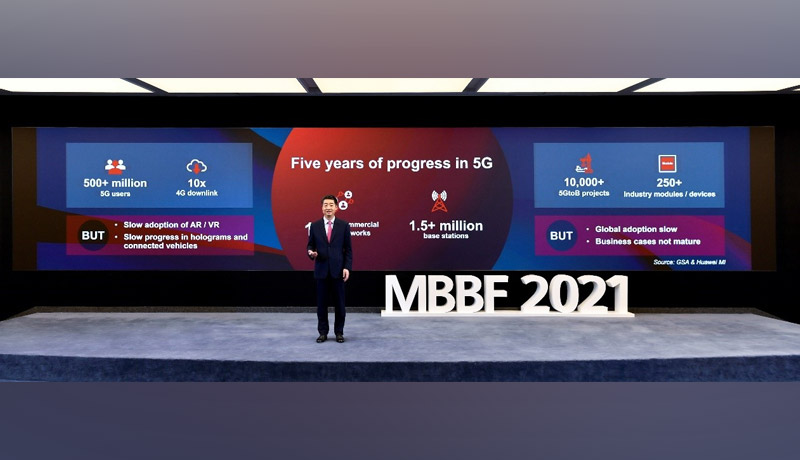
The 12th annual Global Mobile Broadband Forum (MBBF) of Huawei began in Dubai with a keynote from Ken Hu, the company’s Rotating Chairman.
He spoke on the current state of 5G development and new opportunities moving forward. “In just five years of commercial deployment, 5G has provided a considerable upgrade in mobile experience for consumers, and it’s already starting to empower different industries around the globe. Progress was much faster than we expected, especially in terms of the subscriber base, network coverage, and the sheer number of 5G terminals on the market.”
Hu outlined three areas of opportunity that will drive the next stage of 5G’s growth, including XR services, the B2B market, and low-carbon development.
There are presently 176 commercial 5G networks serving more than 500 million subscribers around the world. Average 5G download rates are around ten times faster than 4G, which has driven widespread adoption of applications such as virtual reality and 360o broadcasting.There are already 10,000 initiatives researching B2B uses of 5G (5GtoB) in the enterprise area around the world. Manufacturing, mining, and port industries have already tested 5G applications, which are now being duplicated at scale.
While progress has been steady, Hu noted that there are still some areas for improvement. “Right now more than half of these 10,000 5GtoB projects are in China. We have a huge number of use cases already, but we need to build more sustainable business cases.”
He went on to speak of broader changes that will have a long-term impact on the ICT industry, including accelerated digital transformation caused by the pandemic, how cloud and AI have become must-haves for all organizations, and how the world is taking climate change more seriously. “These trends provide many opportunities for our industry,” he said. “But they also create some challenges. There are a few things we can do to get ready.”
First, the industry needs to get networks, devices, and content ready for explosive growth in Extended Reality (XR). To support a smooth cloud-based XR experience, networks need to provide download speeds faster than 4.6 Gbit/s with latency no greater than 10 milliseconds. “Last year,” noted Hu, “we released our goals for 5.5G. And we believe they will help address this challenge.”
On the device side, lowering barriers to headset adoption is critical to reaching a tipping point in virtual reality, one of the key technologies in the Extended Reality repertoire of AR, VR, and MR. “To reach [this tipping point], we have to make improvements to both headsets and content. For headsets, people want devices that are smaller, lighter, and more affordable.” To enrich the content ecosystem, Hu called on the industry to provide cloud platforms and tools that simplify content development, which is notoriously difficult and expensive.
Second, telecom operators need to enhance their networks and develop new capabilities to get ready for 5GtoB. Because a strong network is essential for 5G industrial applications, operators must continue to develop network capabilities such as uplink, location, and sensing. O&M can be a big difficulty in industrial circumstances because they are far more sophisticated than consumer scenarios. Huawei is working on autonomous networks to aid with everything from planning and construction to maintenance and optimization of 5G networks.
Different responsibilities are also required for digital transformation. Operators can provide connection as well as cloud service providers, systems integrators, and other services, as well as develop the necessary capabilities. It is also critical to develop industry-specific telecoms standards in order to stimulate widespread use of 5G in industries. Operators in China, in collaboration with their industrial partners, have begun developing guidelines for using 5G in industries such as coal mining, steel, and electric power, which has aided in the growth of adoption in these sectors.
“Beyond technology,” concluded Hu, “these are some of the intangible strengths that won’t provide immediate profit, but will be key to long-term competitiveness in the 5GtoB market.”
Third, the industry needs to get ready to go green. According to the World Economic Forum, by 2030, digital technology can help reduce global carbon emissions by at least 15%. “On one hand,” said Hu, “we have a great opportunity to help all industries cut emissions and improve power efficiency with digital technology. On the other hand, we have to recognize that our industry has a growing carbon footprint, and we have to take steps to improve that. Right now Huawei is using new materials and algorithms to lower the power consumption of our products, and we’re remodeling sites, and optimizing power management in our data centers for greater efficiency.”
“We have seen so many changes in the past two years – with the pandemic, technology, business and the economy,” Hu concluded.”Moving forward, as the world begins to recover, we need to recognize the opportunities in front of us and get ready for them. Get our technology ready, get our businesses ready, and get our capabilities ready.”
Huawei, in collaboration with its industry partners GSMA and the SAMENA Telecommunications Council, is hosting the Global Mobile Broadband Forum 2021. Mobile network operators, vertical industry leaders, and ecosystem partners from around the world will join at the forum to explore how to leverage the promise of 5G and propel the mobile industry forward.